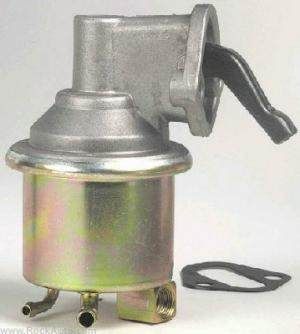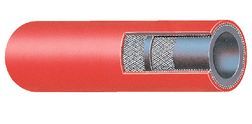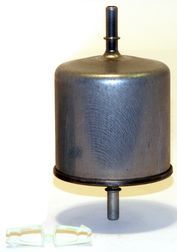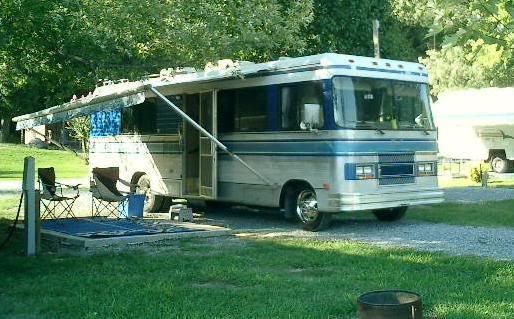Page 1 2
Go to...  | Start A New Topic  | Search  | Notify  | Tools  | Reply To This Topic  |  |
 6/12 6/12Formally known as "Humbojb"  |
If it's OK with everybody, I thought I'd start a new thread on fuel lines rather than keep it with Dick and Bev's fire post in 'General' I have done a preliminary inspection of my 85 Regal/Psomething/Chev454. From the carb to the mech. fuel pump is a solid metal tube that attaches to the fuel pump and the carb. From the inlet side of the fuel pump there is a 6" rubber hose to a metal fuel line, clamped with hose clamps. It looks almost new. The metal line goes back toward the mid tank and before it gets there, the metal line is connected to a fuel filter with rubber hoses on either end. Again hose clamps are used. Up til now there is one small line running next to the main fuel line. I guess it's for venting? These two lines connect to the thing that switches fuel supply from the mid tank to the rear tank. Then a rubber line plus two small lines continues back toward the rear tank. There is another fuel filter in the large fuel line and one fuel filter on one of the small lines. What are these two small lines for? Do you think that originally the big rubber line going to the rear fuel tank was metal? It does connect to a metal line coming from the rear tank about two feet before you get to the rear tank. Also, have a question about the mid tank, that was installed by Barth. If you look in the filler door area, there is no vent like you would expect. But if you look on top of the tank, you can see the filler hose going to the tank and right next to it a vent hose that follows the filler hose as it goes up through the floor of the motor home. But where does it vent? It's right below a window. I do know that when we fill the mid tank we get a lot of gas smell in the Barth. I have no idea where this mid tank vent vents. Hope someone else can give me a clue. I've got to fix it to stop the smell. Thanks for all the help Jim
| |||||||||||
|
| The Old Man and No Barth |
I think you're going to have to trace that vent line to see where it terminates. Since it follows the filler hose up from the tank, but doesn't terminate in the fuel filler compartment, it could be venting directly into the coach, & that's a definite no-no. You should check the filler hoses as well. Yours is a 1985. On my 1990 Regal SE, the filler hose had deteriorated, & I had a fuel smell inside the coach until the tank was about half-empty. I had to cut the bottom out of the black water holding tank compartment, & drop the holding tank to access both ends of the fuel filler hose. Not much fun, & the worst of several items needed to bring that coach up to snuff. Check all of your rubber lines. If the ends are swollen or cracked, or if they bulge where they connect to metal, they should be replaced. Better to do it at home than on the highway somewhere. Better still to prevent a fire. While you're at it, it would be a good idea to replace all those fuel filters. Then you'll know if it ever quits on you, that it isn't the fuel system. | |||
|
Captain Doom |
The small line may be fuel return line - I'm not real familiar with TBI on 454s, but some arrangments supply an excess of fuel, with the retun going back to the tank. There also might be carbon canisters in the vent lines, part of the emissions system. But they would have to be traced to figure out. Rusty '94 28' Breakaway: MilSpec AMG 6.5L TD 230HP Nelson and Chester, not-spoiled Golden Retrievers Sometimes I think we're alone in the universe, and sometimes I think we're not. In either case the idea is quite staggering. - Arthur C. Clarke It was a woman who drove me to drink, and I've been searching thirty years to find her and thank her - W. C. Fields | |||
|
 3/23 3/23 |
I am not sure what rules were required for M/H but until well after 1985 emission regs were very different for trucks rated as 1 ton and up in the mid-range. The fuel tank vent may have simply discharged to the pavement. If the line has deteriorated this could explain the odor. If there is a recovery canister near the engine disregard, maybe. | |||
|
Captain Doom |
Yeah, I agree - emissions stuff was applied very wierdly in the late '80s - on trucks and such. Rusty '94 28' Breakaway: MilSpec AMG 6.5L TD 230HP Nelson and Chester, not-spoiled Golden Retrievers Sometimes I think we're alone in the universe, and sometimes I think we're not. In either case the idea is quite staggering. - Arthur C. Clarke It was a woman who drove me to drink, and I've been searching thirty years to find her and thank her - W. C. Fields | |||
|
| The Old Man and No Barth |
An '85 has a carburetor, not TBI. The small lines undoubtedly return excess fuel to the tank from the fuel pump. I've had several 454s, & all had that feature. Made for lots of fun when I installed a second tank on a pickup I used to tow a trailer. The critical problem here is the fuel smell inside the coach. The only way to track that down is to trace where that vent line terminates, & be certain of its integrity, & the integrity of the filler hose(s). My other suggestions are more concerned with reliability. This is a safety issue. | |||
|
Where did this line start on the engine side of it? Mike | ||||
|
| First Month Member |
On my 85, there was a small rubber line connected to the underside of the fuel pump, right alongside the larger rubber supply line. (on edit) Just like Mike's p[icture below. . 84 30T PeeThirty-Something, 502 powered | |||
|
The attached picture is a Carter from an '82. The smaller line on the left is called a vapor return line. Mike  | ||||
|
Glassnose Aficionado |
Whenever I've filled the mid tank, I always smelled gas until I learned to run 20 miles or so to burn off the top bit of gas, then switch to the rear and run as usual. I attributed it to expansion due to temp change, and it has always worked since. I never fill past when the pump clicks off, and I try not to fill the mid tank, more than 7/8 or so, and have no trouble as long as I don't top off, so I believe in my case it was expansion. 79 Barth Classic | |||
|
 6/12 6/12Formally known as "Humbojb"  |
In my case, I think I have two problems with the mid tank First, I've got to figure our where that vent line is going and fix it because it sure isn't venting. Second, I have filled it and stopped as soon as the pump handle kicked off and immediately seen fuel on the ground underneath the tank. This leads me to think that not only do I have a venting problem but I probably have some hoses that are bad, too. Fortunately, dropping the mid tank is easy. It's only 20 gallons, has a drain plug and two bolts later it's on the ground,(sort of). I'll keep everyone appraised.
| ||||||||||||
|
"Host" of Barthmobile.com 1/19 1/19 |
I'm going to say something that most will think "Well, yeah!" But trust me, some do not know. In the interest of making sure no one makes a mistake I fell compelled to point out the obvious. Fuel hose is not the same a radiator hose. An upper radiator hose may look good and have the correct bends, but it will degrade and rot away before long. I've chased many of motorhomes, buses and big rigs and can tell you that the correct hoses are not always used in the manufacturing or repair of equipment. I've seen instances where laziness, rushing, the lack of proper materials So, what do I use? Because of the tendency to use whatever you have on the service truck, for anything, to get the unit rolling at 3am. I've gone to using a nitrate style hose. Napa sells a red colored fuel line that works on gasoline, diesel, vacuum, windshield washer fluid, motor oil and air lines. I've used this style hose for many things and can tell you that it is thicker and very flexible. This is the only type of "Low PSI" hose we carry on our service trucks. Link and picture in case the below "hot link" link stops working  Attributes: Product Features:For Handling Lower Pressure Air, Water, Agricultureal Spraying, Oil or Grease. Also can be Used for Air Spray Paining. Nitrile Tube and Cover Provide High Oil Resistance. Two Braid Polyester, Working Pressure: 250 psi 21 hits for the type of "Multi-purpose hose" that I use. On another, related note. Ford uses a plastic clip to attach their fuel line to the filters. These clips should be replaced at each fuel filter change and should come in the box with the filter. This is the fuel filter that I use on my Barth. It is an inline fuel filter that is fed from the fuel tanks electric fuel pump and is located 1/2 way up the length of my 33' coach. Right around the generator's exhaust system. My fuel filter is under psi when I turn the key on.  In case the hot link to the picture stops working, here is the link to the same image as above, in it, you'll see the clips that I'm talking about.
| |||||||||||||||
| ||||||||||||||||
 6/12 6/12Formally known as "Humbojb"  |
Bill. what type of clamps do you use and can you post a link so I can see what they look like? Thanks Jim PS And what are you doing up at 5 in the morning?
| ||||||||||||
|
| First Month Member |
Bill, is that NAPA hose marked SAE-30-R-something or other? . 84 30T PeeThirty-Something, 502 powered | |||
|
"Host" of Barthmobile.com 1/19 1/19 |
I am assuming you're talking about the rubber hose and not the filter clamps? If so, then regular worm clamps. But, because this is slightly thicker, but still just as pliable, you might need a little fatter clamp. Use a shielded hoses clamp if possible. Going to bed for the first time since Thursday nite. I have another "Emergency Road Service" call so I thought I would check the site before heading out. I saw that I needed to correct a mistake and to respond to this post. It says 172MPA on it. Don't know what it means, but that's what it says. Because Napa uses decimals on these hoses I thought I would give you a link to convert them... decimals to fractions Part number NBHH1704 & Item#: NBHH1705 is listed as an inside diameter of .375" - that is the same as a 3/8 line. The website says the 1704 is rated at 250psi and the 1705 is rated at 500psi. Both are the same ID, the OD is larger on the 1705.
| |||||||||||||||
| ||||||||||||||||
| Powered by Social Strata | Page 1 2 |
| Please Wait. Your request is being processed... |
|
This website is dedicated to the Barth Custom Coach, their owners and those who admire this American made, quality crafted, motor coach.
We are committed to the history, preservation and restoration of the Barth Custom Coach.
We are committed to the history, preservation and restoration of the Barth Custom Coach.





